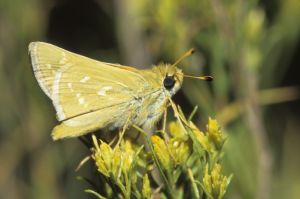Chapter 5. Grass Selection and Butterfly Pairings
5.2 Wildflower and Grass Pairings
As discussed in Chapter 2, native grasses benefit butterflies and moths during their larval stage. During this stage, these insects are small and earthbound, and so are not very mobile. Lepidoptera do most of their traveling during their adult stage, when they can fly and traverse longer distances. To attract Lepidoptera to a planting, grasses should be paired with wildflowers that provide food for their adult stage.
There is a lot of information available on how to attract pollinators using floral resources. However, there is less information out there about grass skippers and other grass-feeding species. Generally, grass skipper butterflies feed on the nectar of flowers that grow in the same type of habitat where their host grasses grow, and that bloom during their butterfly life span. They seem to prefer composites and other flowers with easily available nectar, but as a group are moderately opportunistic in their choices for nectar. Many grass skipper species have short life spans as butterflies, sometimes only 3–5 weeks. They can only use the flowers that are blooming during the window of time that they are flying. Different species emerge as butterflies at different times during the spring and summer season, taking advantage of different floral resources.
Complete Life Cycle Table

To benefit Lepidoptera during their whole life cycle, plant both the nectar flowers for the adult stage and the host plants for the larval stage. The following table list combinations of nectar flowers and grasses that serve Lepidoptera species during both their butterfly and larvae life stages.This list was compiled by searching the literature (guidebooks and scientific journal articles) and taking note of adult nectar plants and larval food plants.
| GRASS | + | FLOWER | = | LEPIDOPTERA |
| big bluestem | bird’s-foot violet | cobweb skipper | ||
| little bluestem | Carolina larkspur | cobweb skipper | ||
| big bluestem | wild hyacinth | cobweb skipper, dusted skipper | ||
| little bluestem | wild strawberry | cobweb skipper, dusted skipper | ||
| switchgrass | viburnum spp. | pepper and salt skipper | ||
| sideoats grama | penstemon spp. | hilltop little skipper | ||
| switchgrass | dogbane | tawny-edge skipper | ||
| switchgrass | purple coneflower | tawny-edge skipper | ||
| big bluestem | common milkweed | Delaware skipper, Ottoe skipper | ||
| big bluestem | pickerelweed | Delaware skipper | ||
| switchgrass | swamp milkweed | Delaware skipper | ||
| big bluestem | ox-eye | Dakota skipper, arogos skipper | ||
| prairie dropseed | black-eyed Susans | Dakota skipper, Poweshik skipperling | ||
| little bluestem | purple coneflower | Dakota skipper, arogos skipper, Poweshik skipperling, Ottoe skipper | ||
| prairie dropseed | leadplant | Ottoe skipper | ||
| lake sedge | Joe Pye weed | northern/marsh eyed brown | ||
| sideoats grama | green milkweed | arogos skipper, Ottoe skipper | ||
| lake sedge | blue vervain | broad-winged skipper | ||
| lake sedge | swamp milkweed | broad-winged skipper | ||
| lake sedge | pickerelweed | Dion skipper | ||
| lake sedge | sneezeweed | Dion skipper | ||
| blue grama | blazing star spp. | common branded skipper | ||
| blue grama | goldenrod spp. | common branded skipper | ||
| blue grama | New England Aster | Leonard’s skipper | ||
| tussock sedge | swamp milkweed | northern/marsh eyed brown | ||
| little bluestem | New Jersey tea | crossline skipper |
Limitations and Possibilities of Butterfly Gardens
While the addition of native nectar flowers into human dominated landscapes has shown to be successful in providing nectar to butterflies (Vickery 1995), there is debate surrounding the efficacy of butterfly gardens as breeding habitat. There have not been any studies on whether restorations or butterfly gardens function as successful breeding habitat for grass skippers. Many of the rare species that are grassland specialists have only been known to occur on native habitat and are not suspected to travel far from their established populations. However, other species of butterflies, such as the Monarch, have shown to be able to successfully use butterfly gardens as breeding habitat. Additional research is needed to fully understand the benefits of native landscaping in suburban and urban areas to Lepidoptera communities and rare species. A main benefit of residential butterfly gardens may be as stepping stones between larger natural areas, where Lepidoptera can obtain nectar before continuing on to permanent habitat (Vickery 1995; Di Mauro et. al. 2007). Hall et al. (2017) suggest new thinking as we continue to learn how to best design and use our man made environments to make them livable for not only us, but our critically important natural world.

